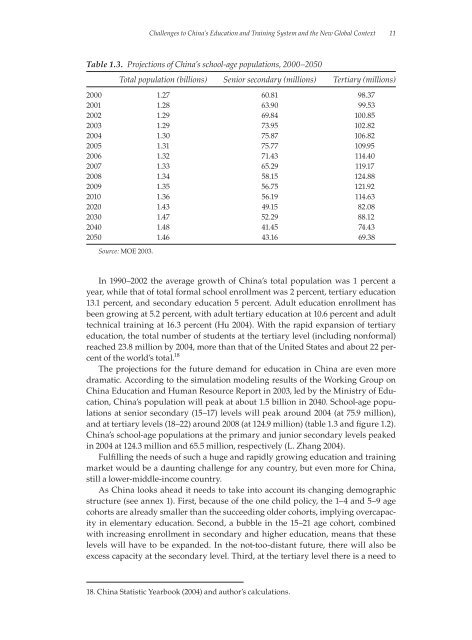Enhancing China's Competitiveness Through Lifelong Learning ...
Enhancing China's Competitiveness Through Lifelong Learning ...
Enhancing China's Competitiveness Through Lifelong Learning ...
Create successful ePaper yourself
Turn your PDF publications into a flip-book with our unique Google optimized e-Paper software.
Challenges to China’s Education and Training System and the New Global Context 11<br />
Table 1.3. Projections of China’s school-age populations, 2000–2050<br />
Total population (billions) Senior secondary (millions) Tertiary (millions)<br />
2000 1.27 60.81 98.37<br />
2001 1.28 63.90 99.53<br />
2002 1.29 69.84 100.85<br />
2003 1.29 73.95 102.82<br />
2004 1.30 75.87 106.82<br />
2005 1.31 75.77 109.95<br />
2006 1.32 71.43 114.40<br />
2007 1.33 65.29 119.17<br />
2008 1.34 58.15 124.88<br />
2009 1.35 56.75 121.92<br />
2010 1.36 56.19 114.63<br />
2020 1.43 49.15 82.08<br />
2030 1.47 52.29 88.12<br />
2040 1.48 41.45 74.43<br />
2050 1.46 43.16 69.38<br />
Source: MOE 2003.<br />
In 1990–2002 the average growth of China’s total population was 1 percent a<br />
year, while that of total formal school enrollment was 2 percent, tertiary education<br />
13.1 percent, and secondary education 5 percent. Adult education enrollment has<br />
been growing at 5.2 percent, with adult tertiary education at 10.6 percent and adult<br />
technical training at 16.3 percent (Hu 2004). With the rapid expansion of tertiary<br />
education, the total number of students at the tertiary level (including nonformal)<br />
reached 23.8 million by 2004, more than that of the United States and about 22 percent<br />
of the world’s total. 18<br />
The projections for the future demand for education in China are even more<br />
dramatic. According to the simulation modeling results of the Working Group on<br />
China Education and Human Resource Report in 2003, led by the Ministry of Education,<br />
China’s population will peak at about 1.5 billion in 2040. School-age populations<br />
at senior secondary (15–17) levels will peak around 2004 (at 75.9 million),<br />
and at tertiary levels (18–22) around 2008 (at 124.9 million) (table 1.3 and figure 1.2).<br />
China’s school-age populations at the primary and junior secondary levels peaked<br />
in 2004 at 124.3 million and 65.5 million, respectively (L. Zhang 2004).<br />
Fulfilling the needs of such a huge and rapidly growing education and training<br />
market would be a daunting challenge for any country, but even more for China,<br />
still a lower-middle-income country.<br />
As China looks ahead it needs to take into account its changing demographic<br />
structure (see annex 1). First, because of the one child policy, the 1–4 and 5–9 age<br />
cohorts are already smaller than the succeeding older cohorts, implying overcapacity<br />
in elementary education. Second, a bubble in the 15–21 age cohort, combined<br />
with increasing enrollment in secondary and higher education, means that these<br />
levels will have to be expanded. In the not-too-distant future, there will also be<br />
excess capacity at the secondary level. Third, at the tertiary level there is a need to<br />
18. China Statistic Yearbook (2004) and author’s calculations.
















